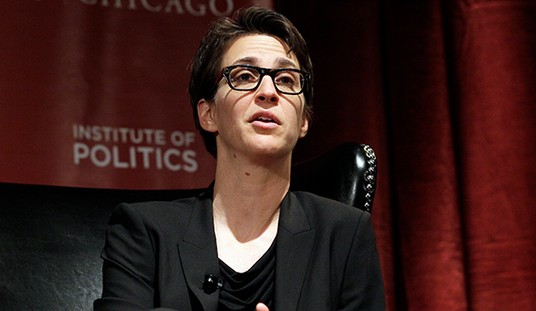Horrid, and just the tip of the iceberg into which the American economy slammed. The shudder running down the nation’s collective spine doesn’t come from today’s GDP report, which showed an annualized contraction of 4.8% in the first quarter of 2020. The shudder comes from imagining what Q2’s report will look like:
The coronavirus pandemic has slammed into the economy so hard the nation’s GDP has fallen by 4.8 percent, bringing the longest economic expansion on record to an abrupt halt.
Gross domestic product, which measures the output of goods and services, sank by 4.8 percent in the first quarter on an annualized basis, according to an initial estimate from the Department of Commerce released Wednesday morning.
It’s the steepest decline since the Great Recession, which ended in 2009. Economic growth was tracking at or above 2 percent until mid-March.
The Q1 contraction came in worse than expected. CNBC notes that economists had projected the GDP number at -3.5%, but that a hard reversal on consumer spending in March made the situation worse:
This marked the first negative GDP reading since the 1.1% decline in the first quarter of 2014 and the lowest level since the 8.4% plunge in Q4 of 2008 during the worst of the financial crisis.
The biggest drags on the economy were consumer spending, nonresidential fixed investment, exports and inventories. Residential fixed investment along with spending from both the federal and state governments helped offset some of the damage.
Consumer expenditures, which comprise 67% of total GDP, plunged 7.6% in the quarter as all nonessential stores were closed and the cornerstone of the U.S. economy was taken almost completely out of commission.
This is what has economists worried about Q2. Bear in mind that most of the damage from COVID-19 took place in just the last three weeks of Q1 as shelter-in-place orders got issued around the country and the White House urged people to follow its initial “15 Days to Flatten the Curve” strategy. What will the economy look like when we do that for six-to-eight weeks, or even longer? Some economists now think Q2’s GDP will be in the range of -20.0%, or even worse.
The spectre of a Q2 crater has the White House and several governors now pressing for reopening the economy. However, that is easier said than done. The transition to a consumer economy means confidence in the system has to be high to get that kind of re-engagement. Just how confident will Americans be to venture back into retail stores and public venues, both as consumers and as workers?
Not terribly confident, the Washington Post reports:
Plans for a swift reopening of malls, factories and other businesses accelerated Tuesday, but they quickly collided with the reality that persuading workers and consumers to overlook their coronavirus fears and resume their roles in powering the U.S. economy may prove difficult. …
Hanging over plans to restart the nation’s economic engine are unprecedented health concerns, as individuals balance each shopping trip, airplane flight and restaurant meal against the risk of catching a sometimes-fatal illness.
“Consumers may have permission to go do something. But whether they go do it depends upon how badly they want to do it and how safe they feel,” said William Dunkelberg, chief economist at the National Federation of Independent Business.
If we reopen too soon (or really, too broadly too soon), we risk spiking hospitalizations past the resources available to effectively treat acute infections. If that happens, areas might need to shut down again, extending the economic damage rather than shortening it:
The administration’s hopes for a swift V-shaped recovery are clouded by the danger that a premature reopening might result in a new surge of infections, which would require some states to order a second shutdown. Besides testing public compliance, such an order could interrupt supply chains.
“This is what matters. The risk is you’ve got to shut down again,” said Steven Blitz, chief U.S. economist for TS Lombard.
The White House plan for a staged reopening still makes the most sense. Its one drawback is its reliance on a level of testing that we still have not yet achieved, at least not in some regions. Minnesota can now conduct 20,000 tests a day, which is probably sufficient for its first-stage reopening two days ago and the broader next step scheduled for next Monday. After that, though, the state will need more capacity to ensure that we have prevented logarithmic spread before we can reopen fully, and some states haven’t yet achieved that level of testing capacity.
If our economy was based more on manufacturing than consumer spending and service industries with close human contact, we could recover more quickly. It’s easier to secure and sanitize manufacturing facilities against pandemics than it is to do so with retail shops and service industry activity. This should provide us with the political impetus to incentivize American firms to relocate more of its manufacturing to the US, even if that means those products cost more. This is a very good reminder about the limits of globalization and the need to orient an economy to creation rather than trading.
Addendum: Consumer spending wasn’t the only dramatic loss. Take a look at what the government mandate for hospitals did to GDP, via Allahpundit.
This is stunning: Nearly half of the Q1 decline in GDP can be attributed to healthcare, which is presumably delaying of elective procedures.
It's a strange reality that in the midst of a pandemic, we have a healthcare-led recession. pic.twitter.com/G3IezQkEzX
— Justin Wolfers (@JustinWolfers) April 29, 2020








Join the conversation as a VIP Member